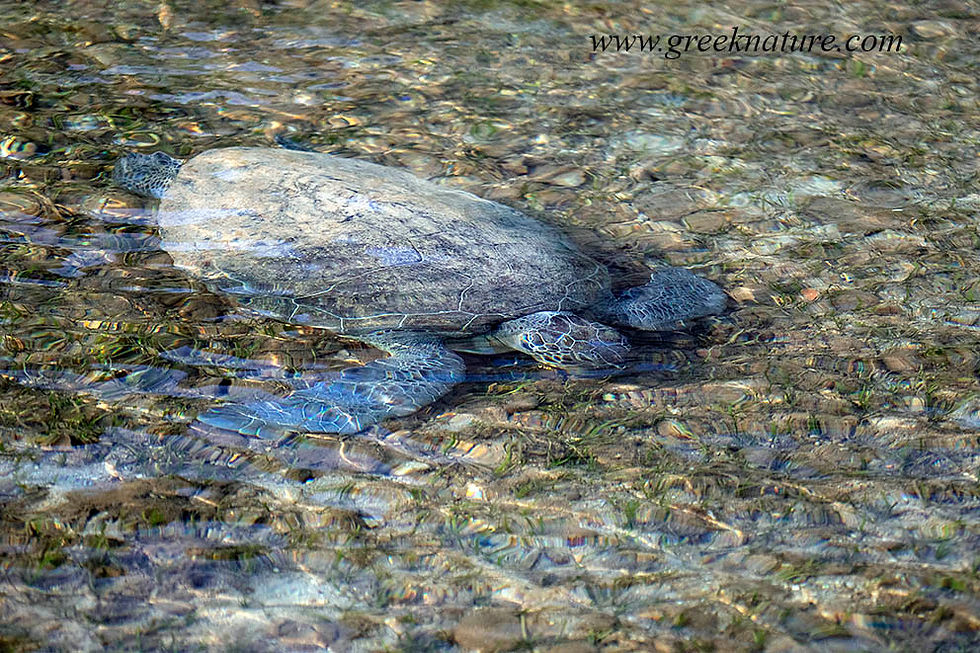Chelonia mydas in Greece: a discovery
- Philippos Katsiyiannis

- Oct 2, 2019
- 4 min read
It was in summer 2017 that I went for a second time to Kastellorizo island, on an extended zoological expedition, looking for reptiles and fruit bats. Friend Kostas Chousalas was extremely obliging, giving to me the keys of his house, so I had a luxurious time to hang around and search the island. It was at that time that I observed the green turtles in the sea around the island, along with the loggerheads that were loafing around the tavernas. Loggerhead Turtles Caretta caretta are known from a number of places to have been accustomed to accept titbits and live in harbours. It is already known that in the main harbour of Kastellorizo there are some of these loggerheads that are regularly fed from the tavernas.



But while looking for turtles, I had a big surprise: apart from the loggerhead turtles that are quite common in Greece, there were some very rare Green Turtles Chelonia mydas. At the beginning I thought that there were only very few, but as I spotted more and more, I understood that in the small harbour these were the "common" turtles and not the loggerheads (which occupied the main harbour).

A number of features can tell apart the two species, but the easiest when you see them from afar is the small head of the green, the different shape of the head, the beak and the eyes, and the "keratin teeth" when you are near enough to see the mouth.

Unlike the Loggerheads, the Green turtles are herbivores and are not concerned for the titbits from the tavernas. They graze peacefully in the shallow small harbour which is like a lagoon, full of sea grasses (mainly Posidonia oceanica and Cymodocea nodosa). As you can imagine, I spent the next few days watching the turtles and trying to photograph them and to understand where they were going to graze. So I found that apart from the main water body, the animals came to extremely shallow depths to graze, and that was very usual. Big animals and very small ones (the size of a terrapin) were coming up to the shore to graze, when people were not there.

I swam and snorkelled with the turtles and was mesmerised by them. I decided to buy an underwater camera and return. The third trip was in spring of 2019 but there were no turtles to be found, all fishermen agreeing that the animals came from May on. So at last, in July 2019 I entered the water -the turtle-infested water- and swam again with them. Th experience was pure magic. The way they fly through the water is mesmerising. The fact that they were so beautiful and rare was only adding to it all.






The turtles were seen in water of 10-15 meters deep, feeding on the bottom, or coming to the surface to breathe, or in shallow water, again feeding on the sea grasses. When the animals were in deep water, it was easy to swim over them and then be very near them when they came to the surface to breathe. The turtles didn't seem to care for you at all and it was great to be just beside them.
On the contrary, when they were feeding in shallow 2-5 metres) or very shallow (0,5 -2 metres) water, they were very shy. The shallower the water was, the shier the turtles became.
The video below shows a green turtle cruising near the bottom
The video below shows a green turtle shoving sand with its front flippers to uncover the grasses on which it feeds









The following video shows an animal feeding on the bottom
And the next one shows a juvenile swimming
I spend the next two days in shallow water, sometimes just under a meter deep. When in deep water, the risk of been hit by a speed boat was very real. Many motor boats came dangerously near me. I also found turtles with scars from collisions, and turtle bones (ribs) on the sea floor. Implementing some speed limits and observing the places where boats are forbidden, is mandatory. There is heavy traffic of speed boats and sail ships in the small harbour where the green turtles live.


In very shallow sea, the water was cloudy. One could see only at two meters distance. I would stand in the shallows with the water up to my knees and see a turtle just 5 meters away, but when immersed in the sea I could not see anything.

The solution was to forget about the animals that were grazing in very shallow sea (o,5-2 meters) and head to deeper water (2-5 meters). There the visibility was better and the turtles more relaxed when approached.

















The discovery was very important because Green turtles are globally threatened and the Mediterranean population even worse. And of course because this is the first feeding ground to be found in Greece with so many turtles of any age and size congregated in such numbers. This led to a small article in Herpetological Bulletin, published by the British Herpetological Society :




Comments